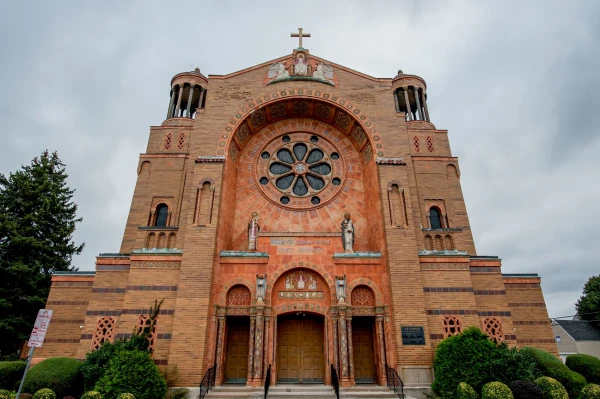CNA Staff, Apr 21, 2024 / 06:00 am
A historic Polish Catholic church in Buffalo, New York — one with a unique connection to St. John Paul II — is facing tens of thousands of dollars in bills that threaten to close the nearly-century-old structure.
Father Czeslaw Krysa, SLD, the parochial vicar of St. Casimir, said the Buffalo Diocese has given the church a deadline of August to pay its outstanding accounts. Among those is $55,000 in annual insurance costs, up recently from $32,000.
Joe Martone, a spokesman for the Buffalo Diocese, said that the diocesan vicar for renewal and development, Father Bryan Zielenieski, “communicated in February to the pastor of the family of parishes [of which] St. Casimir is a member that the church had entered a one-year evaluation period to determine its financial viability.”
“Our diocese is in a family of parishes model, and the families are currently evaluating all aspects of parish life including financial sustainability,” Martone said.
The Buffalo Diocese in 2020 filed for Chapter 11 bankruptcy as part of compensation for victims of clergy sex abuse. The diocese in March announced the sale of its headquarters in downtown Buffalo after nearly 40 years at that location.

Supporters of St. Casimir recently launched a GoFundMe effort to preserve the historic church and its worship community. Krysa said the church itself has “been in the black for nine out of the last 12 years,” in part because it is entirely volunteer-run. The church is also in the process of selling its social center, formerly the parish school, located several blocks away.
Krysa, who was first introduced to the church as a seminarian years ago, said St. Casimir operates “more like a shrine” than a traditional parish.
“We have a core group that runs the place and worships each Sunday,” he said. “And then we have what we call ‘event liturgies,’ which draw people like they were coming to a shrine.”
“These are liturgies that are not available at other parishes in the diocese,” he said.
‘An exquisite example of old Byzantine architecture’
The cornerstone of Buffalo’s St. Casimir Catholic Church was laid in 1927 and the structure was completed in 1929. It has stood for nearly 100 years, displaying what one local architecture critic calls “an exquisite example of old Byzantine architecture” reminiscent of the world-famous Hagia Sophia in Istanbul.
The church’s richly adorned exterior includes multiple cupolas, a towering 65-foot dome, and a large rose window on a facade set off by eight stone millions. Visible on the facade is a terra cotta mural depicting Christ the King, St. Casimir, St. Stanislaus, and St. Hyacinth.
The interior of the church, meanwhile, includes murals by Marion Rzeznik, a Polish native born in 1899. Among its architectural features are a fully preserved ambo including the original abat-voix, a barrel-vaulted and coffered ceiling, statuary lining both sides of the pews, and the original ad orientem high altar over which is a rendering of the coronation of Mary, the Mother of God.
Krysa told CNA that the church offers Masses that employ the “five senses” — sight, taste, touch, hearing, and smell.
“During every single worship, liturgy, or devotion, all the five senses are engaged in praising and experiencing God,” the priest said.
“Our main mission is to continue our heritage, which is an ethnic Roman Catholic heritage,” the priest added. He explained that though the church started out as a Polish parish, “we’re diversifying.”
St. Casimir was first made an oratory in 2009 before receiving its present free-standing designation in 2011, Krysa said.The free-standing designation means that the church “is canonically aligned with the diocese,” Martone told CNA. “Other churches in New York are separately incorporated. So, St. Casimir is a free-standing church under the administrative jurisdiction of the diocese.”
Hosting the future Pope John Paul II
(Story continues below)
Subscribe to our daily newsletter
At Catholic News Agency, our team is committed to reporting the truth with courage, integrity, and fidelity to our faith. We provide news about the Church and the world, as seen through the teachings of the Catholic Church. When you subscribe to the CNA UPDATE, we'll send you a daily email with links to the news you need and, occasionally, breaking news.
As part of this free service you may receive occasional offers from us at EWTN News and EWTN. We won't rent or sell your information, and you can unsubscribe at any time.
Click hereThe church’s Polish roots became known around the country in 1976 when St. Casimir was paid a visit by then-Cardinal Karol Józef Wojtyła. The prelate in two years’ time would go on to be elected Pope John Paul II.
Wojtyła was visiting the United States as part of that year’s International Eucharistic Congress; during his visit he traveled across the country, stopping in Buffalo to visit the city’s large population of Polish immigrants.
“He was awestruck about this church. He loved it,” David Grzybek, a lifelong member of the parish, told the Buffalo News last month.
Wojtyła stayed two days at the parish. The bedroom in which he stayed has since been preserved as a memorial to the historic pope, its spartan interior remaining identical in appearance to when the cardinal slept there nearly 50 years ago. The room is used by the faithful for prayers, Krysa told CNA.
Our mission is the truth. Join us!
Your monthly donation will help our team continue reporting the truth, with fairness, integrity, and fidelity to Jesus Christ and his Church.
Donate to CNA
